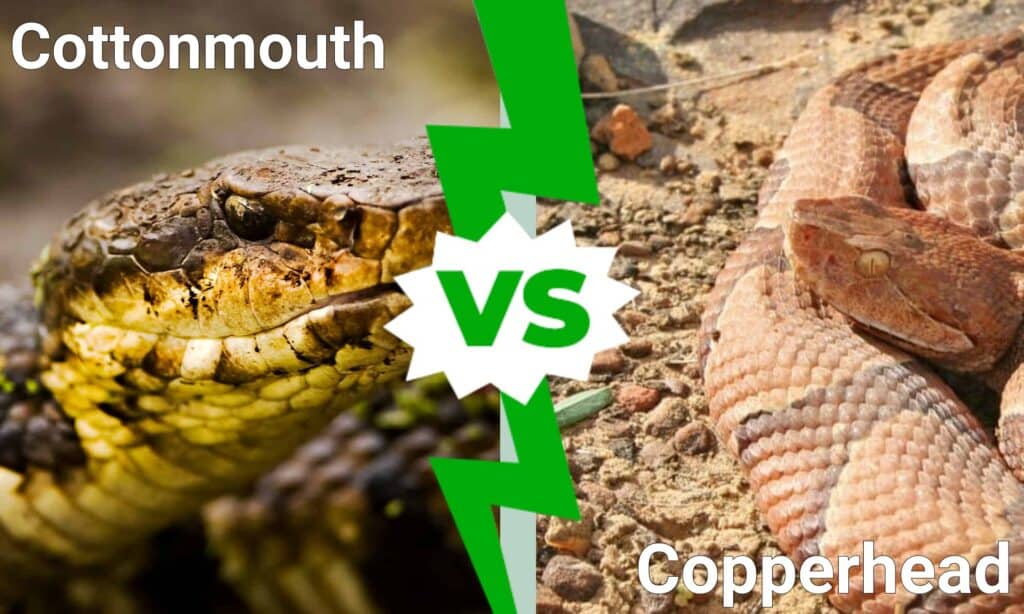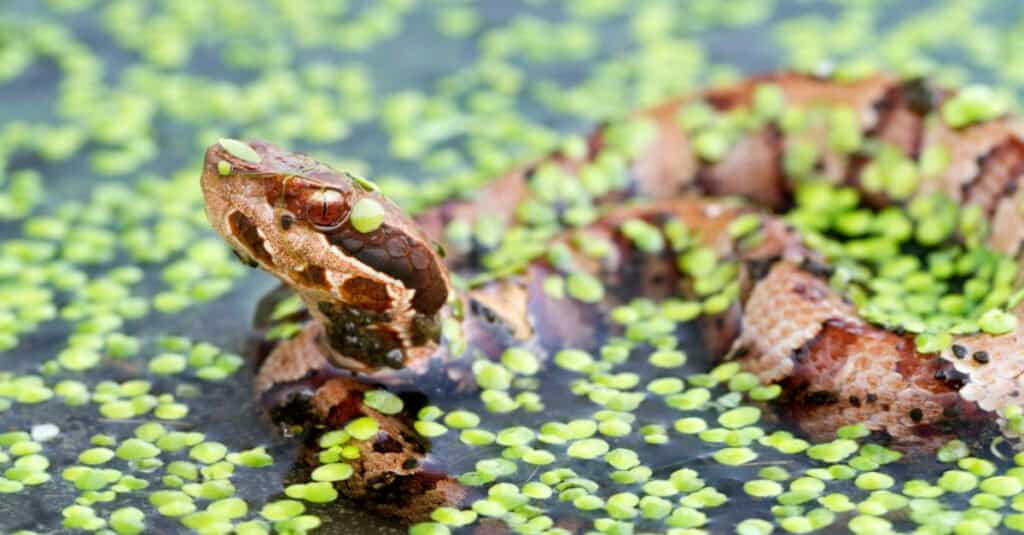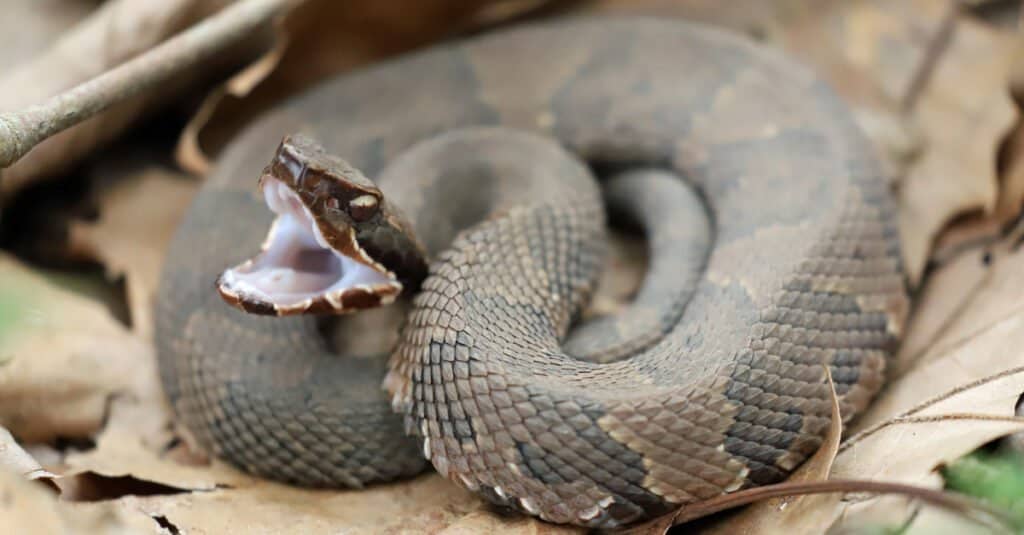Cottonmouth vs Copperhead: What’s the Difference?
Key Points
- Cottonmouths are generally wider and longer in size than copperheads, and also more venomous.
- Cottonmouth snakes, also known as water moccasins, prefer wet environments like swamps, marshes, rivers and lakes. Copperheads thrive in dry environments like rocky areas, mountains, and woods.
- Copperheads maintain their intricate patterns and reddish or copper skin tones throughout their adult life. Cottonmouths, in comparison, become darker and more plain looking as they age.
- Cottonmouths are more venomous than copperheads, and both typically get aggressive only if they are defending their territory or feel threatened.
It is important that you know the differences between a cottonmouth vs copperhead snake, given their inherent dangers and characteristics. While both of these snakes are members of the same genus, they are technically different species. However, this does not make them easy to identify or tell apart- that’s why we’re here to help.
In this article, we will address all of the key differences between cottonmouths and copperheads, including their preferred habitats and how they appear. This may help you better identify them should you happen to stumble upon one in the wild. Let’s get started and learn how to tell these two snakes apart!

A-Z-Animals.com
Comparing Cottonmouth vs Copperhead
| Cottonmouth | Copperhead | |
|---|---|---|
| Genus | Agkistrodon | Agkistrodon |
| Location | Southeastern United States, from Florida to Texas | Southern US and Southern New England; Mexico |
| Habitat | Wet regions, such as swamps, marshes, rivers, and lakes | Rocky areas, mountains, woods, suburban wood piles and construction zones |
| Appearance | Banded or solid; often brown, black, or tan in color with a stripe across the eye. Adults are less colored than babies, and their mouths are white. | Banded; copper, tan, red, or pink in color. Very intricately patterned and designed from birth til adulthood. Mouth is pink in color, though they rarely show it. |
| Size | 5-50 inches in length, depending on age | 20-35 inches in length, depending on age |
The Main Differences Between Cottonmouth vs Copperhead

Mark_Kostich/Shutterstock.com
There are many key differences between a cottonmouth vs copperhead. While both of these snakes are considered venomous, cottonmouths are widely considered to be more venomous than copperheads are. The snakes also prefer different habitats, and their coloring and appearances differ from one another as well. However, it can be hard to tell the difference between these two snakes if you have an untrained eye.
Let’s discuss the differences between these two snakes now.
Cottonmouth vs Copperhead: Size and Species
While cottonmouths and copperheads belong to the same genus and family of snakes, there are some key differences in their overall size. For the most part, cottonmouths are largely considered to be bigger than copperheads. These snakes are both wider and longer than copperheads are, sometimes to an extreme degree.
For example, the average cottonmouth grows anywhere from five to 50 inches in length, while the average copperhead tends to stop growing anywhere from 20 to 35 inches in length. Cottonmouths also have a much wider body than copperheads do.

Jeff W. Jarrett/Shutterstock.com
Cottonmouth vs Copperhead: Location Found
Another difference between cottonmouths and copperheads is where they are typically found. These snakes are located throughout the majority of the United States, and sometimes these snakes can be found in the same geographical area. However, there are some key locations where they are likely to be found.
Cottonmouth snakes are often discovered in the southeastern United States, particularly throughout Florida and Texas. This is different from copperheads when you consider that copperheads stretch as far as Southern New England and into northern Mexico. However, copperheads are also found throughout the Southern United States, just like cottonmouths.
Cottonmouth vs Copperhead: Habitat

Katie Flenker/Shutterstock.com
The preferred habitats of cottonmouths differ from copperheads. While copperheads tend to prefer environments that are warm and dry, cottonmouths are usually found near bodies of water.
Cottonmouths are also known as water moccasins. The nickname “water moccasin” came from its dark tan, brown, or black skin that has a pattern of dark brown or black crossbands which resemble the leather stitches of moccasin shoes. Also, cottonmouths are the only venomous water snakes in North America.
Both cottonmouths and copperheads are versatile in their environmental adaptations, but cottonmouths are often known for their aquatic behavior. They tend to spend their time in marshy environments and wetlands, while copperheads prefer mountainous or wooden areas. Copperheads can also be found in suburban areas, but often in locations that offer them protection, such as wood piles or construction sites.
However, as previously mentioned, cottonmouths and copperheads can be found in the same locations, including their preferred habitat. Cottonmouths will retreat to dryer land and protection should their wetlands or marshlands dry up during the warmer months of the year.
Cottonmouth vs Copperhead: Appearance

Jeff W. Jarrett/Shutterstock.com
Another key difference between a cottonmouth versus copperhead lies in their overall appearance. Cottonmouths are less intricately patterned and colored when compared to copperheads, though it can be extremely difficult to tell these two snakes apart when they are young. Copperheads tend to maintain the same coloring and patterns as they age, while cottonmouths become more plain as they age.
Just as their namesake implies, copperheads are often found in copper and reddish coloring, particularly their triangle heads. Cottonmouths may also be found in a tan color with dark banding, but they tend to become darker in color as they age. However, cottonmouths may be identified from copperheads by looking closely at their eyes.
This is because most cottonmouths have a distinct band or stripe across their eyes, while copperheads do not. Another difference between these two snakes, should you get close enough, is that cottonmouths have white mouths while copperheads have pink mouths. However, we do not recommend getting that close to either of these snakes!
Cottonmouth vs Copperhead: Venom Strength

KF2017/Shutterstock.com
A final difference between cottonmouths and copperheads lies in the strength of their venom. Copperheads are largely considered to be less venomous than cottonmouths, and some studies show that you may not need antivenom if you are bitten by a copperhead. However, you should always be cautious when dealing with any sort of snake, as any snake bite will be painful, whether or not it is venomous.
Both the cottonmouth and copperhead have reputations for being aggressive snakes, but neither will typically seek out to bite humans or pets. Rather, they will both defend their ground if they feel they’re in danger. As with most wildlife, give copperheads and cottonmouths their space, and they will typically leave you alone as well.
Summary of Cottomouth vs. Copperhead
Here’s some key take-away facts about cottomouths and copperheads:
| Trait | Cottonmouth | Copperhead |
|---|---|---|
| Location | Southeast US from Florida to Texas | Southern US, Southern New England, Mexico |
| Habitat | Rivers, Lakes, Swamps, Marshes | Mountains, woods, rocky areas, construction sites |
| Appearance | Banded or solid; brown, black, or tan; stripe across eye; becomes more plain looking with age | Banded; copper, tan, red, or pink; maintains intricate design through adulthood |
| Size | 5-50 inches in length, depending on age | 20-35 inches in length, depending on age |
Up Next…
If snakes are your thing, find out more about them in these informative articles.
- The 6 Most Poisonous Snakes in Florida Planning a trip to the Panhandle? Then you may want to figure out in advance which snakes to watch out for.
- Cottonmouth vs. Rattlesnake: 5 Key Differences Want to know how cottonmouths and rattlesnakes differ? How they are similar? Read on.
- 10 Most Beautiful Snakes in the World So many great choices, but here are our top picks of the most beautiful snakes on a global scale.
Discover the “Monster” Snake 5X Bigger than an Anaconda
Every day A-Z Animals sends out some of the most incredible facts in the world from our free newsletter. Want to discover the 10 most beautiful snakes in the world, a “snake island” where you’re never more than 3 feet from danger, or a “monster” snake 5X larger than an anaconda? Then sign up right now and you’ll start receiving our daily newsletter absolutely free.
More from A-Z Animals
Key Points
- Cottonmouths are generally wider and longer in size than copperheads, and also more venomous.
- Cottonmouth snakes, also known as water moccasins, prefer wet environments like swamps, marshes, rivers and lakes. Copperheads thrive in dry environments like rocky areas, mountains, and woods.
- Copperheads maintain their intricate patterns and reddish or copper skin tones throughout their adult life. Cottonmouths, in comparison, become darker and more plain looking as they age.
- Cottonmouths are more venomous than copperheads, and both typically get aggressive only if they are defending their territory or feel threatened.
It is important that you know the differences between a cottonmouth vs copperhead snake, given their inherent dangers and characteristics. While both of these snakes are members of the same genus, they are technically different species. However, this does not make them easy to identify or tell apart- that’s why we’re here to help.
In this article, we will address all of the key differences between cottonmouths and copperheads, including their preferred habitats and how they appear. This may help you better identify them should you happen to stumble upon one in the wild. Let’s get started and learn how to tell these two snakes apart!

A-Z-Animals.com
Comparing Cottonmouth vs Copperhead
| Cottonmouth | Copperhead | |
|---|---|---|
| Genus | Agkistrodon | Agkistrodon |
| Location | Southeastern United States, from Florida to Texas | Southern US and Southern New England; Mexico |
| Habitat | Wet regions, such as swamps, marshes, rivers, and lakes | Rocky areas, mountains, woods, suburban wood piles and construction zones |
| Appearance | Banded or solid; often brown, black, or tan in color with a stripe across the eye. Adults are less colored than babies, and their mouths are white. | Banded; copper, tan, red, or pink in color. Very intricately patterned and designed from birth til adulthood. Mouth is pink in color, though they rarely show it. |
| Size | 5-50 inches in length, depending on age | 20-35 inches in length, depending on age |
The Main Differences Between Cottonmouth vs Copperhead

Mark_Kostich/Shutterstock.com
There are many key differences between a cottonmouth vs copperhead. While both of these snakes are considered venomous, cottonmouths are widely considered to be more venomous than copperheads are. The snakes also prefer different habitats, and their coloring and appearances differ from one another as well. However, it can be hard to tell the difference between these two snakes if you have an untrained eye.
Let’s discuss the differences between these two snakes now.
Cottonmouth vs Copperhead: Size and Species
While cottonmouths and copperheads belong to the same genus and family of snakes, there are some key differences in their overall size. For the most part, cottonmouths are largely considered to be bigger than copperheads. These snakes are both wider and longer than copperheads are, sometimes to an extreme degree.
For example, the average cottonmouth grows anywhere from five to 50 inches in length, while the average copperhead tends to stop growing anywhere from 20 to 35 inches in length. Cottonmouths also have a much wider body than copperheads do.

Jeff W. Jarrett/Shutterstock.com
Cottonmouth vs Copperhead: Location Found
Another difference between cottonmouths and copperheads is where they are typically found. These snakes are located throughout the majority of the United States, and sometimes these snakes can be found in the same geographical area. However, there are some key locations where they are likely to be found.
Cottonmouth snakes are often discovered in the southeastern United States, particularly throughout Florida and Texas. This is different from copperheads when you consider that copperheads stretch as far as Southern New England and into northern Mexico. However, copperheads are also found throughout the Southern United States, just like cottonmouths.
Cottonmouth vs Copperhead: Habitat

Katie Flenker/Shutterstock.com
The preferred habitats of cottonmouths differ from copperheads. While copperheads tend to prefer environments that are warm and dry, cottonmouths are usually found near bodies of water.
Cottonmouths are also known as water moccasins. The nickname “water moccasin” came from its dark tan, brown, or black skin that has a pattern of dark brown or black crossbands which resemble the leather stitches of moccasin shoes. Also, cottonmouths are the only venomous water snakes in North America.
Both cottonmouths and copperheads are versatile in their environmental adaptations, but cottonmouths are often known for their aquatic behavior. They tend to spend their time in marshy environments and wetlands, while copperheads prefer mountainous or wooden areas. Copperheads can also be found in suburban areas, but often in locations that offer them protection, such as wood piles or construction sites.
However, as previously mentioned, cottonmouths and copperheads can be found in the same locations, including their preferred habitat. Cottonmouths will retreat to dryer land and protection should their wetlands or marshlands dry up during the warmer months of the year.
Cottonmouth vs Copperhead: Appearance

Jeff W. Jarrett/Shutterstock.com
Another key difference between a cottonmouth versus copperhead lies in their overall appearance. Cottonmouths are less intricately patterned and colored when compared to copperheads, though it can be extremely difficult to tell these two snakes apart when they are young. Copperheads tend to maintain the same coloring and patterns as they age, while cottonmouths become more plain as they age.
Just as their namesake implies, copperheads are often found in copper and reddish coloring, particularly their triangle heads. Cottonmouths may also be found in a tan color with dark banding, but they tend to become darker in color as they age. However, cottonmouths may be identified from copperheads by looking closely at their eyes.
This is because most cottonmouths have a distinct band or stripe across their eyes, while copperheads do not. Another difference between these two snakes, should you get close enough, is that cottonmouths have white mouths while copperheads have pink mouths. However, we do not recommend getting that close to either of these snakes!
Cottonmouth vs Copperhead: Venom Strength

KF2017/Shutterstock.com
A final difference between cottonmouths and copperheads lies in the strength of their venom. Copperheads are largely considered to be less venomous than cottonmouths, and some studies show that you may not need antivenom if you are bitten by a copperhead. However, you should always be cautious when dealing with any sort of snake, as any snake bite will be painful, whether or not it is venomous.
Both the cottonmouth and copperhead have reputations for being aggressive snakes, but neither will typically seek out to bite humans or pets. Rather, they will both defend their ground if they feel they’re in danger. As with most wildlife, give copperheads and cottonmouths their space, and they will typically leave you alone as well.
Summary of Cottomouth vs. Copperhead
Here’s some key take-away facts about cottomouths and copperheads:
| Trait | Cottonmouth | Copperhead |
|---|---|---|
| Location | Southeast US from Florida to Texas | Southern US, Southern New England, Mexico |
| Habitat | Rivers, Lakes, Swamps, Marshes | Mountains, woods, rocky areas, construction sites |
| Appearance | Banded or solid; brown, black, or tan; stripe across eye; becomes more plain looking with age | Banded; copper, tan, red, or pink; maintains intricate design through adulthood |
| Size | 5-50 inches in length, depending on age | 20-35 inches in length, depending on age |
Up Next…
If snakes are your thing, find out more about them in these informative articles.
- The 6 Most Poisonous Snakes in Florida Planning a trip to the Panhandle? Then you may want to figure out in advance which snakes to watch out for.
- Cottonmouth vs. Rattlesnake: 5 Key Differences Want to know how cottonmouths and rattlesnakes differ? How they are similar? Read on.
- 10 Most Beautiful Snakes in the World So many great choices, but here are our top picks of the most beautiful snakes on a global scale.
Discover the “Monster” Snake 5X Bigger than an Anaconda
Every day A-Z Animals sends out some of the most incredible facts in the world from our free newsletter. Want to discover the 10 most beautiful snakes in the world, a “snake island” where you’re never more than 3 feet from danger, or a “monster” snake 5X larger than an anaconda? Then sign up right now and you’ll start receiving our daily newsletter absolutely free.







